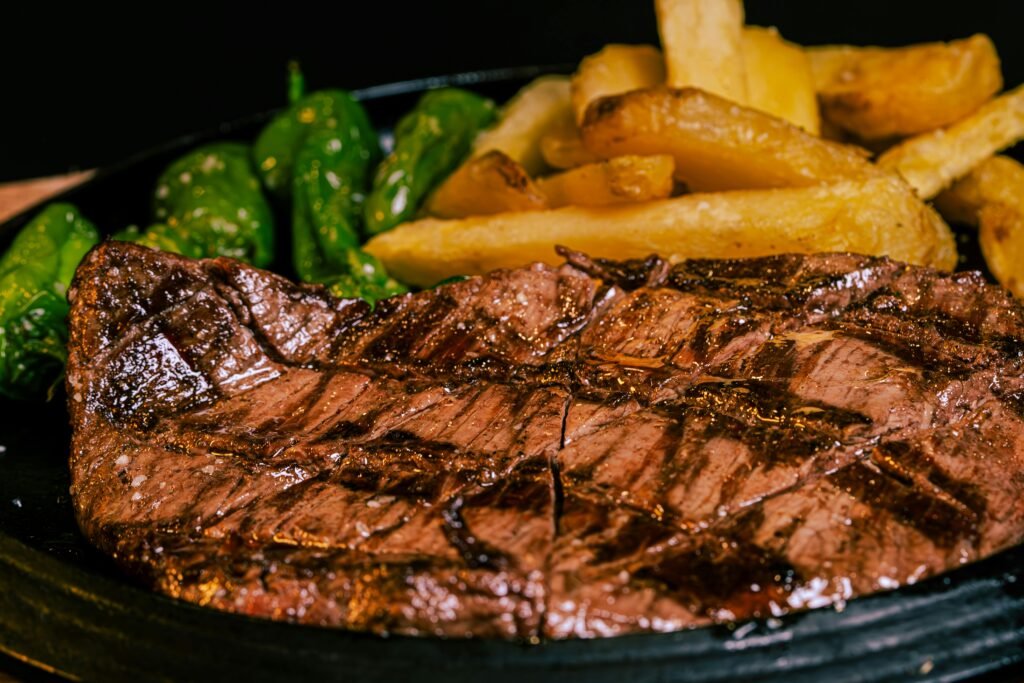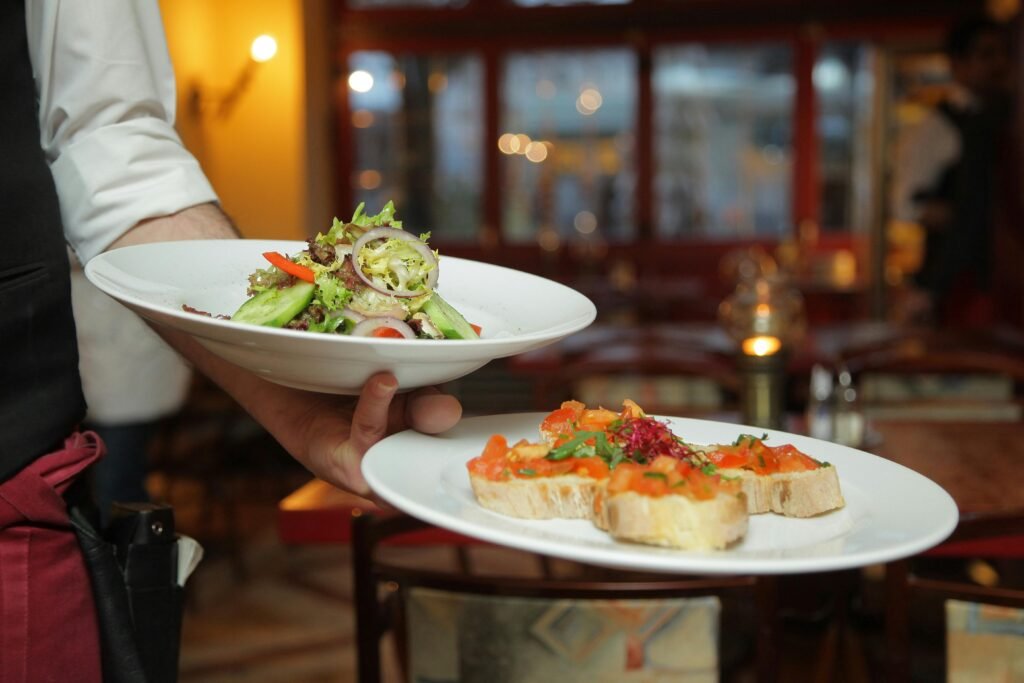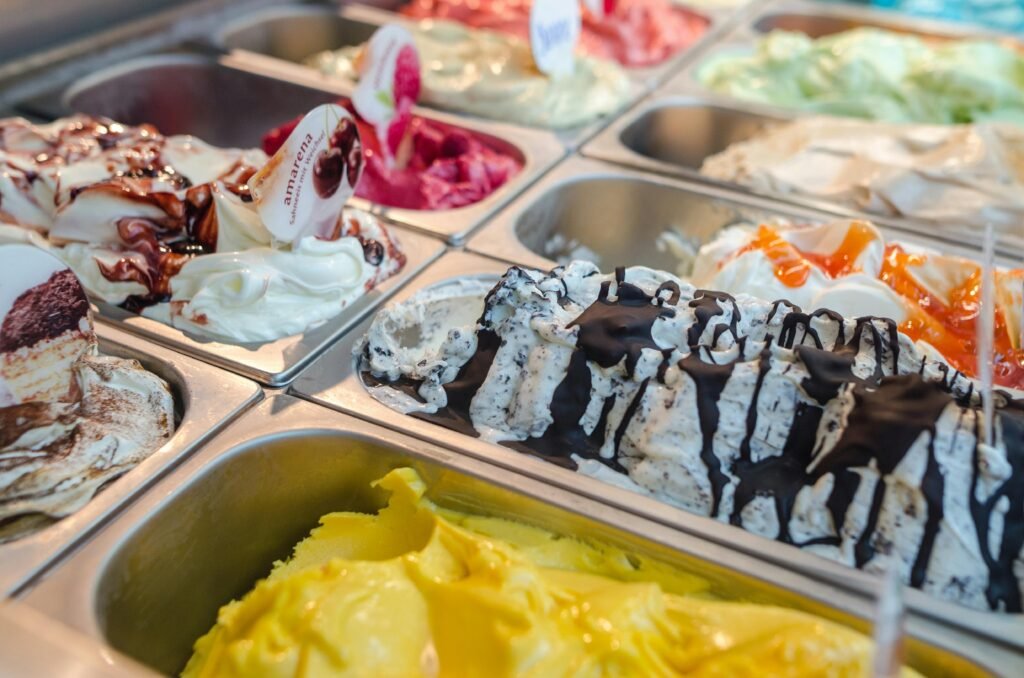Florence isn’t just the birthplace of the Renaissance – it’s also home to some of Italy’s most incredible culinary traditions.
After spending countless hours wandering through local markets, making embarrassing pronunciation mistakes, and occasionally ordering the wrong thing entirely, I’ve learned that eating in Florence is about so much more than just filling your stomach.
It’s about understanding centuries of tradition, family recipes, and the pure joy that comes from simple, high-quality ingredients.
Traditional Florentine Dishes You Can’t Miss
Bistecca alla Fiorentina: The King of Steaks
This isn’t your average steak – it’s a thick, bone-in T-bone from Chianina cattle that’s been dry-aged to perfection. The traditional way to prepare it is pretty simple: high heat, salt, pepper, and olive oil. That’s it. No fancy marinades or complicated seasonings.
I made the rookie mistake of trying to order one for myself during my first visit. The waiter actually laughed and explained that these massive steaks are meant to be shared between two or three people. We’re talking about cuts that can weigh over two pounds!
Here’s what you need to know: it’s always served rare to medium-rare, period. Don’t even think about asking for it well-done – you’ll get some serious side-eye from both the chef and your server. The meat is so tender and flavorful that cooking it beyond medium-rare would honestly be a crime against nature.
The best places to try authentic bistecca? Skip the touristy spots near major attractions and head to Il Latini or Trattoria Sostanza. These family-run establishments have been perfecting their technique for generations.
Ribollita: Comfort in a Bowl
Ribollita literally means “reboiled,” and this hearty soup perfectly represents Florence’s no-waste philosophy that I’ve grown to absolutely love.
This isn’t some fancy restaurant creation – it’s peasant food at its finest. Traditional ribollita starts with leftover minestrone soup that gets reheated (hence the name) with stale bread, beans, and whatever vegetables are in season. Kale, cabbage, carrots, onions, and cannellini beans are the usual suspects.
I learned to make this from my landlord’s mother during a month-long stay in Florence. She’d start the soup in the morning, let it simmer all day, and then reheat it for dinner with thick slices of day-old Tuscan bread. The bread completely transforms the texture, making it thick and almost stew-like.
Lampredotto: For the Adventurous Eater
Okay, I’m gonna be real with you here – lampredotto is definitely not for everyone. It’s basically cow’s fourth stomach served in a sandwich, and yes, it sounds way more intimidating than it actually is.
I avoided trying it for my entire first week in Florence because, let’s be honest, the idea of eating stomach lining didn’t exactly scream “delicious” to me. But peer pressure from my Italian friends finally won, and I’m so glad it did.
The meat is slow-cooked for hours with tomatoes, onions, parsley, and celery until it becomes incredibly tender. It’s served on a crusty roll, often with salsa verde (a tangy herb sauce) or hot sauce.
Your best bet for trying authentic lampredotto is at the food trucks around Mercato di Sant’Ambrogio or near the Basilica of Santo Spirito. These aren’t fancy sit-down spots – they’re literally street vendors who’ve been perfecting their recipes for decades.
Must-Try Tuscan Specialties
Pici Pasta: Hand-Rolled Heaven
Pici might just be the most underrated pasta shape in all of Italy, and I’m willing to die on this hill.
These thick, hand-rolled pasta noodles look almost like fat spaghetti, but the texture is completely different. They’re irregular, rustic, and absolutely perfect for holding onto rich sauces. Making pici is surprisingly simple – just flour, water, and olive oil – but getting the technique right takes practice.
I spent an entire afternoon with Nonna Maria (not actually my grandmother, but that’s what everyone called her) learning to roll pici by hand. My first attempts looked more like wonky earthworms than pasta, but she was incredibly patient. The key is to roll from the center outward with both palms, creating these beautiful irregular noodles.
The classic preparation is pici all’aglione – with a simple tomato and garlic sauce that lets the pasta shine. Some places also serve it with wild boar ragu or cacio e pepe style. Whatever sauce you choose, make sure it’s a good one because pici deserves respect.
Schiacciata: Florence’s Answer to Focaccia
If you think all Italian flatbreads are the same, schiacciata will change your mind real quick.
This Tuscan specialty is thinner and more delicate than focaccia, with a crispy exterior and soft, airy interior. The traditional version is simply topped with coarse salt and olive oil, but you’ll find variations with grapes (schiacciata all’uva), herbs, or vegetables.
I discovered the best schiacciata purely by accident while wandering around the San Lorenzo market area. The smell from this tiny bakery was absolutely irresistible, and I ended up buying way more than I could possibly eat. The baker explained that good schiacciata should have irregular bubbles and holes – that’s how you know it’s been properly fermented.
Pro tip: schiacciata makes an incredible sandwich bread. Slice it horizontally and stuff it with prosciutto, fresh mozzarella, and arugula for the perfect picnic lunch.
Sweet Treats and Desserts
Gelato vs. Ice Cream: There IS a Difference
Let me settle this debate once and for all – gelato and ice cream are not the same thing, and anyone who says otherwise hasn’t had real Italian gelato.
The difference comes down to air content and fat percentage. Gelato has less air churned into it, making it denser and more intensely flavored than American ice cream. It’s also served at a slightly warmer temperature, which allows the flavors to really pop on your tongue.
Finding authentic gelato in Florence can be tricky because there are tons of tourist traps selling mediocre frozen desserts. Here’s my foolproof method: look for gelato that’s stored in metal containers with lids, not the pretty mounded displays in glass cases. Real gelato makers know that exposure to air and light ruins the texture and flavor.
My go-to spots are Vivoli (they’ve been making gelato since 1930) and La Carraia. Both places focus on traditional flavors made with high-quality ingredients. Skip the neon-colored options and go for classics like pistachio, stracciatella, or seasonal fruit flavors.
Cantucci: The Perfect Coffee Companion
These twice-baked almond cookies might look simple, but they’re absolutely addictive when done right.
Traditional cantucci (also called biscotti di Prato) are hard, crunchy cookies that are meant to be dunked in Vin Santo, a sweet dessert wine. The combination is pure magic – the wine softens the cookies just enough while the almond flavor intensifies.
I learned to make these from a pastry chef who insisted that good cantucci should have whole almonds, not chopped pieces. The dough is shaped into logs, baked once, then sliced and baked again until golden. The double-baking process is what gives them that characteristic crunch.
Even if you’re not a wine drinker, cantucci are fantastic with espresso or cappuccino. Just don’t try to eat them without dunking – you might break a tooth!
Where to Find Authentic Food in Florence
Local Markets: Your Gateway to Real Florence
Forget the restaurants for a minute – if you really want to understand Florentine food culture, you need to hit up the local markets.
Mercato Centrale is probably the most famous, but it’s become pretty touristy over the years. For a more authentic experience, I always recommend Mercato di Sant’Ambrogio. This smaller market is where actual Florentines do their shopping, and the vendors are way more willing to chat and share cooking tips.
I spent hours at Sant’Ambrogio just watching how locals select their ingredients. They smell everything, ask detailed questions about where the produce came from, and have heated discussions with vendors about the best way to prepare different items. It’s like a masterclass in Italian food culture.
The cheese vendors, in particular, are absolute goldmines of information. They’ll let you taste different aged parmesans, explain the differences between various pecorinos, and recommend wine pairings. Just be prepared to buy something – they’re generous with samples, but it’s good etiquette to purchase if you’re taking up their time.
Hidden Gems Off the Beaten Path
Some of my best food discoveries in Florence happened completely by accident, usually when I was lost and looking for something else entirely.
Trattoria da Rocco, tucked away near Piazza Santa Croce, doesn’t even have a proper sign – just a small plaque by the door. The menu changes daily based on what’s fresh at the market, and the owner, Rocco himself, comes out to explain each dish. His ribollita is hands-down the best I’ve ever had.
Another incredible find is Osteria Santo Spirito, which locals just call “Santo Spirito.” It’s in the Oltrarno district, away from the main tourist areas. The space is tiny – maybe ten tables – and they don’t take reservations. You just show up, put your name on a list, and wait. Trust me, it’s worth it.
The key to finding these places is to look for spots where you hear more Italian than English, where the menu isn’t translated into four languages, and where the servers aren’t aggressively trying to get you inside.
Food Etiquette and Cultural Tips
Dining Times: When Romans… Er, Florentines Eat
One of my biggest culture shocks was adjusting to Italian meal times. If you show up at a restaurant at 6 PM expecting dinner, you’re gonna be out of luck.
Lunch typically happens between 12:30 and 2:30 PM, and most restaurants close completely between 3 and 7 PM. Dinner service doesn’t usually start until 7:30 or 8 PM, and many locals don’t sit down to eat until 9 PM or later.
I made the mistake of trying to grab dinner at 6:30 PM during my first week, and the restaurant host looked at me like I’d asked to eat breakfast at midnight. He politely explained that the kitchen wouldn’t be open for another hour and suggested I grab an aperitivo to tide me over.
This actually turned out to be great advice. Aperitivo hour (roughly 6-8 PM) is a fantastic way to experience Italian social culture. You order a drink and get access to a spread of small snacks – olives, cheese, cured meats, little sandwiches. It’s not meant to be a full meal, but it’s perfect for holding you over until dinner time.
Coffee Culture: Don’t Be That Tourist
Italian coffee culture is serious business, and there are definite rules you should know about.
First off, cappuccino is strictly a morning drink. Ordering one after a meal, especially dinner, marks you as a tourist immediately. Italians believe that milk interferes with digestion, so afternoon and evening coffee is always espresso-based without milk.
I learned this the hard way when I ordered a cappuccino after lunch at a small café near the Duomo. The barista didn’t say anything, but I could see the judgment in his eyes. The Italian businessman next to me actually leaned over and quietly explained the unwritten rule.
Also, most Italians drink their coffee standing at the bar, not sitting at a table. Table service usually comes with an extra charge, and the coffee experience is meant to be quick – in and out in five minutes max.



